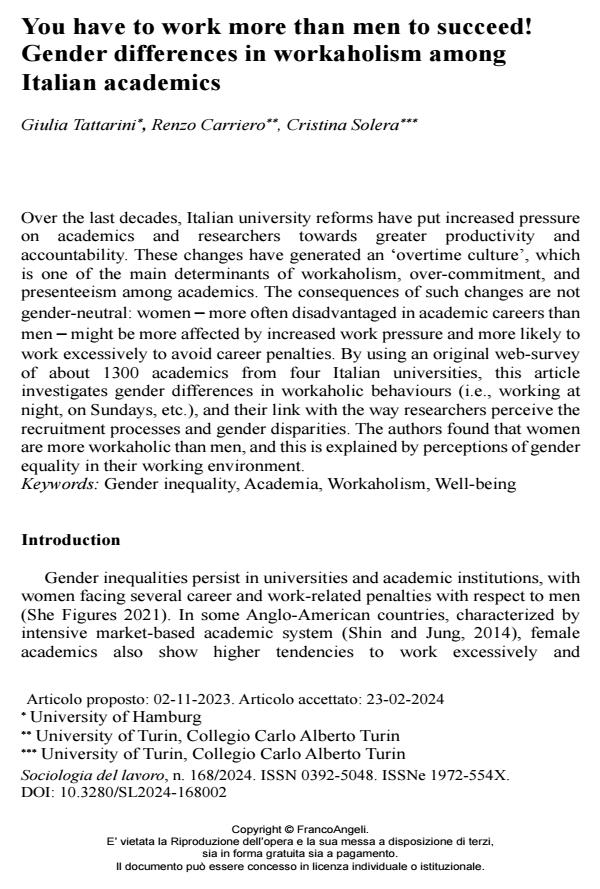You have to work more than men to succeed! Gender differences in workaholism among Italian academics
Journal title SOCIOLOGIA DEL LAVORO
Author/s Giulia Tattarini, Renzo Carriero, Cristina Solera
Publishing Year 2024 Issue 2024/168
Language English Pages 22 P. 28-49 File size 271 KB
DOI 10.3280/SL2024-168002
DOI is like a bar code for intellectual property: to have more infomation
click here
Below, you can see the article first page
If you want to buy this article in PDF format, you can do it, following the instructions to buy download credits

FrancoAngeli is member of Publishers International Linking Association, Inc (PILA), a not-for-profit association which run the CrossRef service enabling links to and from online scholarly content.
Over the last decades, Italian university reforms have put increased pressure on academics and researchers towards greater productivity and accountability. These changes have generated an ‘overtime culture’, which is one of the main determinants of workaholism, over-commitment, and presenteeism among academics. The consequences of such changes are not gender-neutral: women – more often disadvantaged in academic careers than men – might be more affected by increased work pressure and more likely to work excessively to avoid career penalties. By using an original web-survey of about 1300 academics from four Italian universities, this article investigates gender differences in workaholic behaviours (i.e., working at night, on Sundays, etc.), and their link with the way researchers perceive the recruitment processes and gender disparities. The authors found that women are more workaholic than men, and this is explained by perceptions of gender equality in their working environment.
Keywords: Gender inequality, Academia, Workaholism, Well-being
- Predictores de la adicción al trabajo entre profesores universitarios de posgrado brasileños Mary Sandra Carlotto, Sheila Gonçalves-Câmara, in Acciones e Investigaciones Sociales /2025
DOI: 10.26754/ojs_ais/accionesinvestig.soc..20254711051 - İşkoliklik ve İş-Aile Çatışmasi İlişkisi: Cinsiyetin Düzenleyicilik Etkisinin İncelenmesi Gökhan Kenek, Tuğçe Şimşek, in Journal of Yaşar University /2025 pp.695
DOI: 10.19168/jyasar.1662265
Giulia Tattarini, Renzo Carriero, Cristina Solera, You have to work more than men to succeed! Gender differences in workaholism among Italian academics in "SOCIOLOGIA DEL LAVORO " 168/2024, pp 28-49, DOI: 10.3280/SL2024-168002